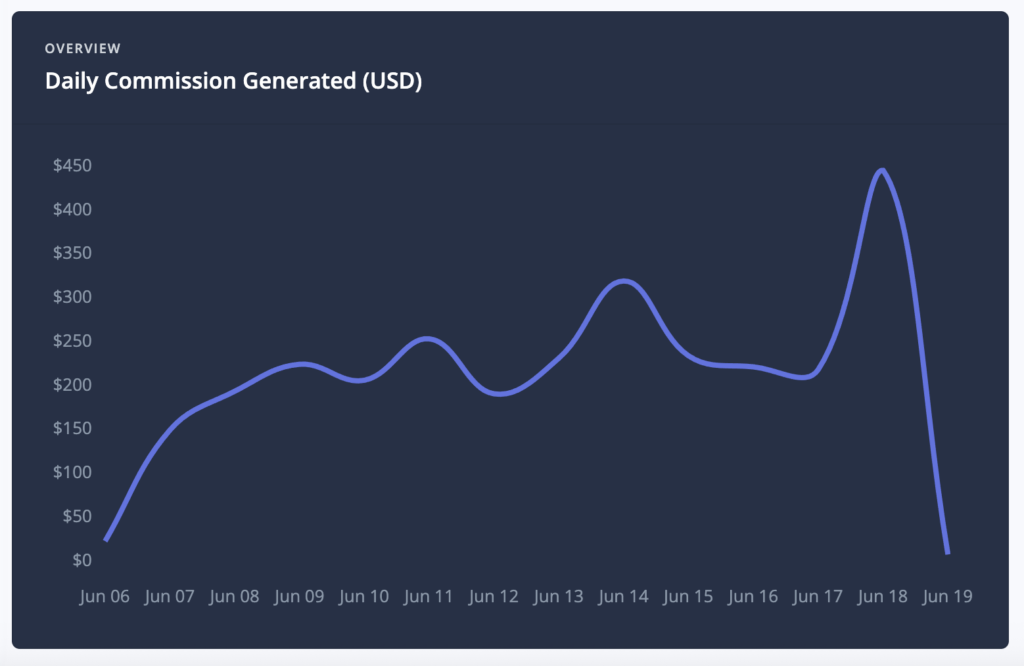There are two things I’m constantly doing with my niche sites in addition to publishing plenty of content. They are:
- Working on increasing revenue per 1,000 visitors; and
- Increasing trafic.
Success with either of those efforts will increase a website’s revenue. Success with both is the ideal.
This article focuses on one way I’ve dramatically increased revenue per one thousand visitors by nearly doubling affiliate commissions without any significant increase in traffic.
Data and Screenshots
I’ll kick this post off with an affiliate commission earnings and timeline chart followed by a traffic chart and earnings screenshots.
1. Commission Chart Timeline

2. Traffic profile for same time period

3. Earnings Screenshots for entire period
Here are screenshots of commissions from the three main affiliate networks from which I earn affiliate commissions (just so you know I’m not making this stuff up):

b. CJ.com merchants:

c. Amazon commissions:

7 Steps I Took to Nearly Double My Affiliate Commissions
Step 1: Analyzed best-selling products and merchants
For the site I’m referring to in this situation, I promote a ton of products on Amazon, Shareasale and CJ.com. Sales are fairly random. However, one product stood out as one that I sold consistently. Even though volume wasn’t terribly high, the key point was that my site was selling it more consistently than all other products. That was the product I decided to really ramp up promotions site-wide. This product was in the CJ.com affiliate network.
Here’s a chart showing affiliate revenue growth from CJ.com during the relevant time period:

Another good reason I chose this particular product is it’s relevant to most visitors. In other words, it has fairly broad appeal within the niche.
Therefore, I set out to leverage my site and audience to ramp up promotion and revenue. At first I had no idea whether it would work. I test a lot of stuff on my sites, most of which doesn’t work out. However, this decision and effort is paying off tremendously well.
Step 2: Contacted merchant and asked for 3 things
Because I had some sales history, I figured why not ask the merchant for a few perks. Here’s what I asked for:
- Higher commission
- Discount code for my readers
- Marketing materials
Fortunately, the merchant said “yes” to all three requests. I’m hopeful that in due course I’ll get yet another bump in commission given my climbing sales volume.
If the merchant declines bumping your commission and/or providing a discount code, ask what sales volume you must achieve in order to get these perks.
Step 3: Added 5 posts promoting this merchant/products
As with most product promotions, there’s usually more content you can publish that will attract more visitors. This was definitely the case with me.
While I had owned this product for some time, I had never done a review. I did that immediately as well published another 4 fairly lengthy articles that promoted the product. I have a few more planned.
Step 4: Implemented Affiliate Link Tracking
I’ve never been diligent with tracking affiliate commissions. This is because I’m lazy and arguably not very smart. Tracking can make a huge difference because if you know what’s earning, you can focus on content and activities that will continue earning.
I finally woke up and smelled the coffee and set up SID tracking in CJ.com. I tracked via individual blog posts, email newsletter and quizzes. This way I could see which pieces of content generated the most sales.
FYI, CJ.com calls it SID for tracking. Other affiliate networks may use different terms. For example, Shareasale calls it afftrack. Amazon calls it unique tracking ID. Clickbank calls it a TID. They all do the same thing and that is give you the opportunity to identify the link in some way so you know the source of the sale.
Sugarrae has a terrific post on setting up tracking and finding the reports for most of the major affiliate networks.
I’ll probably incorporate more affiliate tracking as I continue focusing on growing my affiliate revenue.
Step 5: Launched a Promotion Sitewide
Because I chose to focus on a product that is relevant to much of my traffic, I launched a site-wide promotion by incorporating links to the articles that promoted the product. I also added my quiz to the bottom of every page in the site. I discuss the quiz below and the results from the quiz.
I also promote the product very early in the email newsletter sequence. I just mention it twice and leave it at that. I’m not pounding email readers over the head. I use the newsletter to send readers back to the site where they will definitely have ample opportunity to see the promotions.
As you’ll see below, the email newsletter is not terribly effective at selling.
Step 7: Enhanced promotion on relevant blog posts
While I was successfully selling the product on a few blog posts, there was definitely room to tweak the in-post promotion by creating far more visible and aggressive promotions in the blog posts. I also provide the discount coupon code the merchant gave me and created 2 prominent promotional zones in each relevant blog post.
Step 8: Created a buying quiz
I saved the best for last.
I created a product buying quiz with OpinionStage. My quiz helps people choose the right product within the product line via a series of product-related questions. One of the results is the product I promote. And no, I don’t give one result regardless of how they answer questions. The quiz has two potential results depending on the answers given.
I placed the quiz at the bottom of the site on every page because it’s relevant and it’s kind of fun to take.
The best part is the quiz converts like gangbusters. A considerable number of sales is attributed to the quiz.
Here’s some data pertaining to the success of the product buying quiz:
1. Quiz engagement

2. Chart showing promotional sources and corresponding revenue
The following is a chart showing how much each promotional source generated for the preceding two weeks (May 9 to 23, 2017):

As you can see, the quiz outperformed all other revenue sources… although I believe the untracked commissions are links in various blog posts so in actual fact, it’s likely affiliate links in blog posts out-earned the quiz. Nevertheless, the quiz has turned out to be a highly effective promotional tool.
2 More Tips
Here are 2 more tips I’ve found effective.
Tip #1: Focus on promoting highest earning merchants
Whenever possible, if there’s a merchant that earns more per click than Amazon, focus on promoting that merchant. The thing is, other merchants can convert as well or even better than Amazon plus offer longer affiliate cookies.
My affiliate revenue analysis has shown that I generate quite a few sales beyond the second day with non-Amazon merchants.
Should you quit promoting Amazon?
Not necessarily. There are some products I promote on Amazon for which I can’t get affiliate links in other ways.
Moreover, it may well be that despite Amazon’s short affiliate cookie, the high conversion rate still out-earns other merchants. Just because a merchant offers a 30 day cookie, doesn’t mean you’ll earn more.
Test both and analyze the numbers. Then focus your promotions.
Tip #2: Cookie Multiple Merchants Whenever Possible
I’ve done this for years very effectively. If you have posts that promote more than one product, link to multiple merchants. This way you can cookie multiple merchants and if a sale is made at any of them, you increase your odds of earning a commission.
You can do this in two ways:
- Link different products to different merchants: If you feature or profile multiple products on one page, you can link out to Amazon from one and then other merchants from the others.
- Offer multiple merchant options for the same product: If you review a single product, you can say something like “check pricing at Amazon / Check pricing at Merchant 2 / Check pricing at Merchant 3”.
Summing It Up
If I had to sum this up in one sentence, it would be to look for one product that will convert well for your audience and promote it like crazy. I’m not saying you need to forego promoting other products, by all means do so. What I’m saying is find that one product you can really give it your all site-wide so that you can boost your overall RPM as fast as possible.

Jon Dykstra is a six figure niche site creator with 10+ years of experience. His willingness to openly share his wins and losses in the email newsletter he publishes has made him a go-to source of guidance and motivation for many. His popular “Niche site profits” course has helped thousands follow his footsteps in creating simple niche sites that earn big.






Great post, thanks! One question: was this top performing product digital or physical? thanks again!
Great question Brian. It’s a digital product. I neglected to set that out. Thanks for asking.
With Google Adsense my site usually gets about a $5-$6 rpm. Is that bad? I’m asking because you mention $15 RPM in your article. I receive 200,000 page views per month and only make around $600. I pump out 2-4 articles per week so it is growing.
$5 to $6 RPM can be good. It really depends on the niche and country from which traffic arrives.
thanks Jon, I have just under 200 pages on my site so still a way to go. There’s quite a bit to write about. How many pages do you have for your biggest earning niche site? Would love to know to give me perspective….. Thanks!
Hi Hayley,
I have about 1,350 published posts. It’s not so much how many. I have a lot for reasons beyond SEO. I’d say the top 100 traffic posts pull in at least 70% of overall traffic.
Hi Jon, enjoyed this blog post – especially as a case – which i love – and with actionable steps. Cheers Alison